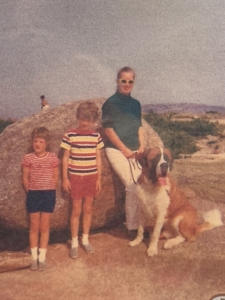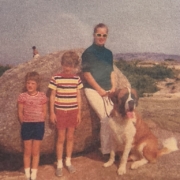Second Chance at the Truth

Tammy on left; Bruno on right.
How do you keep internal peace under external pressure?
There are times that your mind analyzes a situation with clarity, yet you’re still triggered emotionally. You can feel trapped in your reaction and blind to a peaceful resolution.
Your mind and body are misaligned. The information your mind gathers and the story your body conveys seem to be on two different tracks, or different intensities of the same track.
The other night, sitting outside for dinner in the chill of winter (the only COVID option) I was met with this kind of mind body misalignment. My dinner date was sharing with me her newest business venture––herbal care. A healing art she had no education in.
I was stunned. My mind was clear that she was putting herself in liability danger and possibly endangering her customer’s well-being. As a 4-year herbal medicine graduate I tried to explain. The conversation was, to say the least, challenging for me.
Returning home with frozen feet and a chill that rose up my spine like a piercing icicle, I huddled in front of my space heater to thaw out. I was still reeling from the conversation and questioned my heightened emotions around the situation.
I felt mentally sound in my position, but emotionally triggered by my friend’s choice.
The next morning my head was nailed to the bed. There was a muscle spasm under my right shoulder blade that prevented me from lifting my head off the pillow! I felt like my body had been high-jacked by an incensed internal being. The aftermath of tension/stress overload!
So, I used a 3rd Eye Practice that allowed me to ask my body questions. It’s a practice that encourages my mind to take a backseat, while my body’s remembering can feel for the answer.
I place one finger lightly between my eyebrows. I let the sensation penetrate so deeply that the base of my skull widens back away from my neck, my eyes float upward and flutter under closed eyelids.
In this expanded position I asked my body, “what are you holding onto, what’s got you so triggered?”
After a quick filing of visuals, I settled on a childhood memory about my Saint Bernard Bruno. I thought, this can’t be the trigger! So, I asked again. And again, I landed on the Bruno story. So, I dug in and looked around to see what I could find.
At the age of 8 or so, I was letting Bruno out of his dog-pen to play in the yard. When exiting the pen his tail got caught in the gate’s hook lock. He pulled and all the fur and skin ripped off the end of his tail! As he wagged his tail blood was flying everywhere!
I screamed for my parents to come quick!
They came running and wrapped Bruno’s tail with paper and plastic. Then off to the vet we raced.
Bruno was fine. But I felt responsible for letting such a horrible thing happen. After all, I let him out of the pen. So, it must have been my fault that he got hurt in the doing. I decided, and formed a belief, that it’s very easy to hurt someone unintentionally.
BINGO! That “feeling state” was the very same “feeling state” I was having in regard to my friend practicing herbal medicine without a license. The guilt and protection my body held––my childhood trauma––was entangled in my clear-minded response to her.
It’s been a week of heating pads, epsom salt baths and resting on a foam roller, while feeling compassion for the little traumatized Tammy who loved her dog. I realized that I hadn’t unintentionally hurt my 4-legged friend, but rather, he’d had an accident. I wasn’t at fault.
In rewriting my old story’s belief, I’ve also soothed my emotional charge toward my friend. My mental position has not changed, but my emotional tolerance has. I can now extend out of my story into hers. And an ease, for her to be on her journey without judgment, has ensued.
I’ve gotten a second chance to align with my life and correct my skewed judgment of fault.
I can thank my friend for the opportunity to reframe this belief-forming story. As I look at it now, it’s been a constant undercurrent influencing my life. I have always looked at life through the lens of, “I could hurt someone!”
Self-aligned strength asks us to dig beneath the surface of our reactivity for a greater, more meaningful, self-aligned truth.


